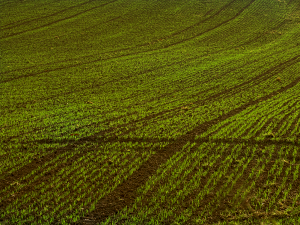 Northwest Region Crop Report Prepared by: Manitoba Agriculture, Food and Rural Development June 13, 2016
Northwest Region Crop Report Prepared by: Manitoba Agriculture, Food and Rural Development June 13, 2016
Northwest Region
Temperatures and rainfall amounts were extremely variable throughout the Northwest Region over the past week. Localized areas around Ste. Rose, Laurier and McCreary received up to 75 mm of rainfall, adding to the already wet field conditions. Crops in this area are yellowing due to excessive moisture. Rainfall amounts north of Ste Rose through Dauphin, Roblin and Swan River ranged between 12 and 28 mm. Soil moisture conditions range from adequate in most parts of the region to excessive in localized parts of the Laurier/McCreary area and the Roblin area.
Seeding operations in the Northwest Region are nearing completion. In general, crop emergence is quite uniform. Most crops throughout the region are progressing well with the exception of those crops impacted by excess moisture conditions. As well, some crops in the Swan Valley that were reseeded due to cutworm damage have yet to emerge. Regionally, 70% of the wheat is at the tillering stage of growth while 30% is elongating. Approximately 20% of the canola is emerging, 80% is seedling and 10% is at the rosette stage of growth. Most of the field peas are in the vegetative stage of growth, while approximately 30% of the soybeans are in the vegetative stage.
Herbicide treatments continue as field conditions allow and as crops reach the proper stage for application. There continue to be reports of flea beetle activity in some canola fields in the Swan River Valley, Roblin and The Pas areas but injury caused by this pest has been minimal. As well, there continue to be cases of cutworms at and above threshold levels in canola, field peas and corn crops in the Swan River Valley. Some of those fields required treatment for cutworms and others had to be reseeded. There were also reports of cutworms at economic thresholds requiring treatment in both The Pas and Roblin areas. Diamondback moth monitoring trap populations continue to be highest in The Pas and Swan Valley areas.
Drier areas north of Swan River and south of Roblin welcomed last week’s rain as forage growth will benefit from the rain. Majority of pastures and hay fields in the area are in good to very good condition, with the exception of areas south of Ste. Rose and McCreary. These areas received 76 mm of rain last week made pastures and fields soft, so any additional moisture will make moving around on them a challenge. Grasses are heading out and the most advanced alfalfa fields are showing a few flowers. Haying has begun for dairy producers but last week’s rain made it challenging to put up high quality feed.
